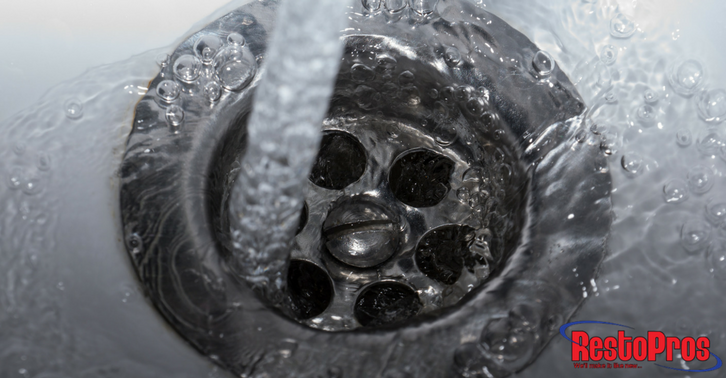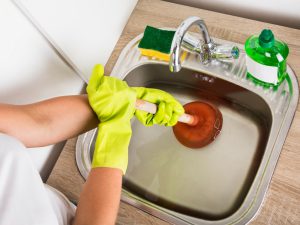 Whether you’re on a septic system or the city’s main sewer system, drain clogs, broken garbage disposals, and sewer backups all have the same effect: pooling water. Unlike a burst high-pressure water line (the pipes flowing to a faucet or fixture), low pressure black- and grey-water lines don’t typically burst from overpressure. Additional debris or garbage that is flushed or drained can cause backups that force water to flow back out of the drain, sometimes even filling their basins and causing overflow.
Whether you’re on a septic system or the city’s main sewer system, drain clogs, broken garbage disposals, and sewer backups all have the same effect: pooling water. Unlike a burst high-pressure water line (the pipes flowing to a faucet or fixture), low pressure black- and grey-water lines don’t typically burst from overpressure. Additional debris or garbage that is flushed or drained can cause backups that force water to flow back out of the drain, sometimes even filling their basins and causing overflow.
Dangers from Backed-Up Drains
Damaged pipes and water leaks can lead to mold growth or damaged walls, ceiling, and insulation. A backed-up drain can cause all of these things by raising relative humidity and it adds in the dangers of dirty water.
While most water lines carry grey-water (used water that is no longer potable) from washing machines and sinks, other water lines carry hazardous human waste. Still worse, common chemical drain cleaners are caustic and, when they fail to clean out a deep clog they aren’t designed for, flow back up the pipe along with all the other hazards, slowly eating away at pipes and leaving a caustic danger for you to deal with.
While these problems are lessened by a simple drain clog, sewer line stoppages are more dangerous since they backup slower and contain water feeds from multiple sources (if your sinks and bathtub backup or gurgle whenever a washing machine drains, then you likely have issues with a sewer pipe). Common household-drain cleaners are not designed to clean out sewer lines and can be hazardous to septic tanks in the first place. If a sink, toilet, or sewer line is ever backed-up enough to overfill and spill out, take care to avoid getting any water on your skin. Use rubber gloves, a mask, and goggles during cleanup.
How to Clear a Clogged Drain
Bent wire hangars and chemical cleaners are not the best way to clean out a clogged drain (and definitely not going to help you with a blocked or broken sewer main). Natural cleaning with vinegar or knowing how to unstop a drain using a plunger are the best ways to clean out a drain, and will work better on deep clogs which chemical cleaners won’t alleviate.
Natural Drain Cleaner:
- Remove all water from the tub or sink, either by allowing it to drain slowly or by using a wet-dry vac.
- Pour 1 cup of baking soda down the drain (make sure it goes into the drain).
- Pour boiling water (not just warm, but boiling water) down the drain. Don’t overfill the drain, roughly 2-3 cups of boiling water should do.
- Wait a few minutes to let the baking soda clear out the drain.
- Add another cup of baking soda and follow with a cup of white vinegar, then plug the drain.
- Wait until the bubbling and fizzing has died down, then run boiling water down the drain.
- Repeat until the sink drain is clear.
If the drain remains clogged after repeated cleanings, try clearing the drain with a plunger.

How to Plunge a Drain:
- Remove the stopper from the sink.
- Place a wet rage in the sink overflow to prevent air from escaping.
- Place the plunger over the drain.
- Add enough water to the sink to cover the rubber cup of the plunger.
- Move the plunger up and down rapidly, do not break the plunger’s seal with the sink.
Your goal is to use pressure to break up the gunk that has been loosened by the baking soda/vinegar mixture from before. Rapid up and down motions with the plunger will force the clog free and allow the water to drain out. Rinse with warm water then sterilize the sink before use.
Don’t forget to follow RestoPros on Facebook, Twitter, LinkedIn, and Google+ for new Updates, News, and Discounts.
